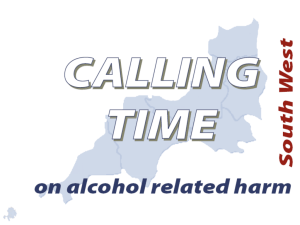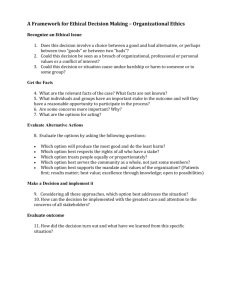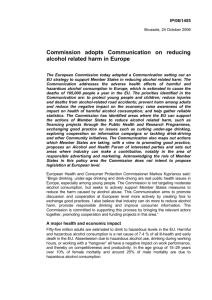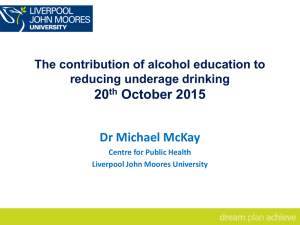Alcohol from a Youth Perspective
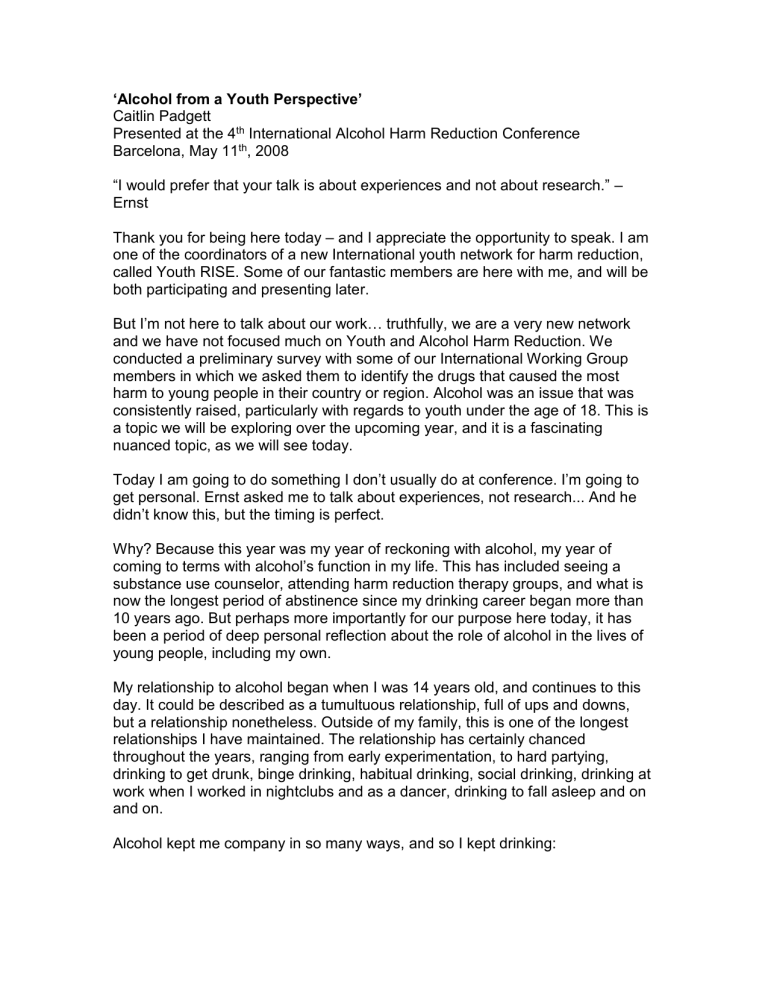
‘Alcohol from a Youth Perspective’
Caitlin Padgett
Presented at the 4 th International Alcohol Harm Reduction Conference
Barcelona, May 11 th , 2008
“I would prefer that your talk is about experiences and not about research.” –
Ernst
Thank you for being here today – and I appreciate the opportunity to speak. I am one of the coordinators of a new International youth network for harm reduction, called Youth RISE. Some of our fantastic members are here with me, and will be both participating and presenting later.
But I’m not here to talk about our work… truthfully, we are a very new network and we have not focused much on Youth and Alcohol Harm Reduction. We conducted a preliminary survey with some of our International Working Group members in which we asked them to identify the drugs that caused the most harm to young people in their country or region. Alcohol was an issue that was consistently raised, particularly with regards to youth under the age of 18. This is a topic we will be exploring over the upcoming year, and it is a fascinating nuanced topic, as we will see today.
Today I am going to do something I don’t usually do at conference. I’m going to get personal. Ernst asked me to talk about experiences, not research... And he didn’t know this, but the timing is perfect.
Why? Because this year was my year of reckoning with alcohol, my year of coming to terms with alcohol’s function in my life. This has included seeing a substance use counselor, attending harm reduction therapy groups, and what is now the longest period of abstinence since my drinking career began more than
10 years ago. But perhaps more importantly for our purpose here today, it has been a period of deep personal reflection about the role of alcohol in the lives of young people, including my own.
My relationship to alcohol began when I was 14 years old, and continues to this day. It could be described as a tumultuous relationship, full of ups and downs, but a relationship nonetheless. Outside of my family, this is one of the longest relationships I have maintained. The relationship has certainly chanced throughout the years, ranging from early experimentation, to hard partying, drinking to get drunk, binge drinking, habitual drinking, social drinking, drinking at work when I worked in nightclubs and as a dancer, drinking to fall asleep and on and on.
Alcohol kept me company in so many ways, and so I kept drinking:
Despite countless mornings waking up sick, disoriented and not able to get out of bed;
Despite the blackouts and many nights I have lost forever due to not remembering;
Despite fighting with parents, partners, friends;
Despite missing work or school, or falling behind;
Despite unwanted and unprotected sexual encounters, and experiences of sexual abuse and rape while intoxicated;
Despite starting and then stopping other drugs such as methamphetamines, cocaine, ecstasy, ketamine and others
Despite hospitalization due to mixing too many pills, party drugs and alcohol;
Despite working for the health authority, in clinics and harm reduction programs, despite counseling others about their substance use, despite therapy…
-
Despite, despite, despite all of this and more, alcohol stayed in my life…
What has become very interesting to me is that I never really considered alcohol a problem. Aspects of drinking were problematic, sure, but the physical effects were normalized and I buried the trauma. Until very recently, I never really examined the sum total of alcohol’s effects on my life. Because it’s legal, and more socially acceptable, it becomes more insidious. I could keep telling myself that the illicit drugs I was using were the real problem, and everything else around me confirmed that. It actually came as quite a shock to me to realize that alcohol was the common denominator throughout most of the drug-related harms
I experienced in my life.
While all of my other preferred drugs might be described as ones that hold me together and keep me going… Alcohol did quite the opposite. Alcohol gave me permission to unravel in ways that I couldn’t otherwise, to access parts of myself that I couldn’t find when I was sober. When my therapist suggested that I stop using alcohol while searching for some clarity about the role it played in my life, I at first didn’t’ think it would be too challenging. But it had been.
Why do I share these experiences with you?
First and foremost, I often feel that what is lacking for most young people is honest and frank discussion about alcohol. Alcohol is the drug that is surrounded by more mixed messages than any other drug. It is also the most visible drug and the most socially acceptable. So while we are young and being told by our elders that alcohol is dangerous, poses health risks and that we should wait until we’re older, many of us just can’t wait to get our hands on the good stuff!
I am also sharing a little of my own experience to illustrate the complexities that we are confronted with when trying to reduce the harms associated with alcohol.
Alcohol is a powerful drug, marketing is a powerful tool, and friends, family and societal pressures can be equally forceful. Advertising that targets young people’s core needs, desires, insecurities, and world-view cannot simply be countered with health messages that warn them about the dangers of alcohol use. Because alcohol will continue fulfilling their needs, and if their needs are still being met, this will override health concerns. I know this from experience. In designing youth harm reduction interventions, we must always look to the underlying causes of substance use.
The formidable task faced by every adolescent – to become an independent and responsible adult
– is undertaken with strategies that may include exploration, experimentation, risk taking, limit testing, and questioning of established rules and sources of authority i . In many of our societies, adolescence is socially defined as a time for selfexploration, trying new things, and if we’re lucky, having fun before the burdensome responsibilities of adulthood.
It is also a time of confusion, of conflicting messages, of pain and hurt, of competing expectations, hopes or dreams. It is the time that we really start feeling differences, whether those differences be related to physical appearances, abilities, gender, sexuality, religion or cultural practices, social class or economic standing. Whether it is the difference between what you want in your future and what you perceive is possible. Whether it is what you see on television, and what you see outside your window.
Alcohol fits into the picture in so many different ways. It bridges the gap between what you have and what you want. It helps calm the competing voices. It gives confidence and soothes doubts and inhibitions. It eases the pain. It provides moments of power, moments of forgetting, moments of pleasure, moments of reckless abandon. Alcohol can be a gift in these ways.
And so we must always remember this, as we move forward trying to reduce the harms of alcohol, we must also remember the gifts it gives and the purpose it serves to the young people who are using it. We must also remember that while there are some biological and developmental similarities between adolescents and young people, there are also many differences.
What does alcohol give to indigenous youth around the world?
What does it give to street children and youth? What needs is alcohol fulfilling?
What does it give to lesbian, gay, bisexual, and transgender youth?
What does it give to youth that are questioning?
What does it give to youth living in poverty, or in developing countries or in rural areas?
I am highlighting these questions and groups in particular because I feel that they will not be sufficiently addressed in the upcoming presentations on binge drinking, the alcohol industry and parents.
Why is harm reduction good practice for young people?
Dr. Alan Marlatt writes that: “Unlike prevention programs for youth that focus exclusively on abstinence and promote a zerotolerance, “just say no” approach, programs based on harm reduction are designed to accommodated those who have “already said yes” or who are leaning in that direction, when it comes to experimenting.
Traditional approaches to alcohol treatment are often not well suited to youth’s developmental needs and tasks. Adolescence is a time for identity create and individuation. Young people are often not ready to “surrender,” or to admit weakness. To the contrary - we are ready to conquer the world and explore everything in it. We do not necessarily have enough life experience to determine whether we have a lifelong problem nor do we want labels that will follow us into our adult lives.
The book Over the Influence, The Harm Reduction Guide for Managing
Drugs and Alcohol, ii defines harm reduction as a holistic and humane public health approach, that includes the following principles:
Not all Drug Use is Abuse
People Use Drugs for Reasons
-
Problems Don’t Just Come from Drugs Themselves but from a Combination of Factors and Circumstances
You are Your Own Expert
Change is Slow
You Can Make Positive Changes While Still Using
Just Say Know: Substance Use Management
Now just substitute “alcohol” for the word drug and we’ve got a good guide for practice.
Not all Alcohol use is abuse
Young people use alcohol for reasons
-
Problems don’t just come from alcohol itself but from a combination of factors and circumstances
You are your own expert, or Youth are their own experts
Change is slow
You can make positive changes with still using/drinking alcohol
When we are talking about youth and alcohol harm reduction, we are talking about so much more than supporting them to “drink responsibly,” limit their intake or consider the health effects. We are talking about learning how to be differently,
how to interact differently, about critical thinking, and cultural and media analysis.
We are talking about body image, and sexuality, and trauma and abuse, and anxieties and fears. These factors must be considered in a holistic approach to harm reduction.
Ten minutes is not very much time to address this topic, and I probably have not served it justice. As we move forward, I would encourage you to ask questions, to challenge your own assumptions about alcohol, your own relationship to alcohol, to ask young people about their opinion or experiences, to be honest about yours.
Thank you very much for the opportunity to speak today. ii Denning, P., Little, J., Glickman, A. (2004) Over the Influence, The Harm
Reduction Guide for Managing Drugs and Alcohol. The Guilford Press, New
York, London. p. 28-37



